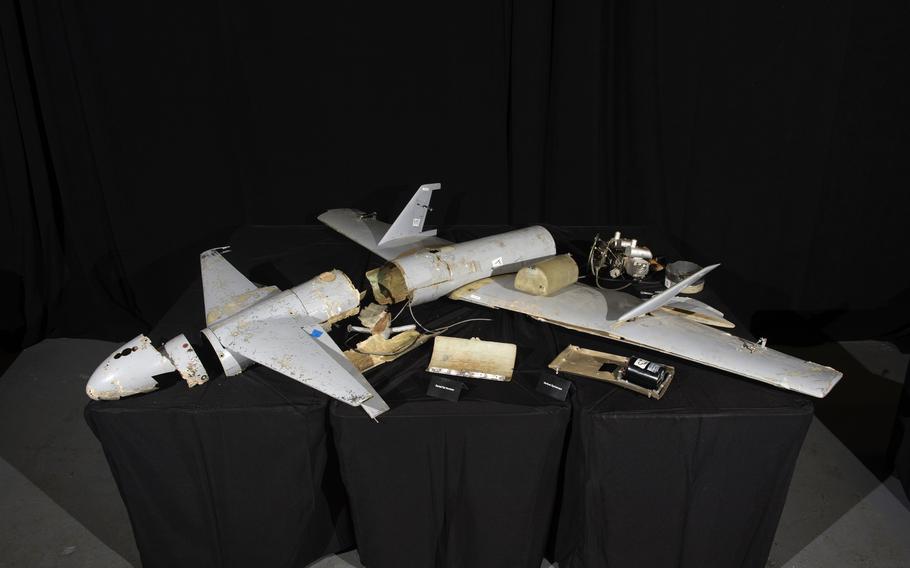
A display shows components of an Iranian Qasef-1 drone at Joint Base Anacostia-Boling in Washington in 2018. A Qasef-1 was what mostly likely struck the U.S. base known as Rumalyn Landing Zone in northeastern Syria on March 23, 2023, weapons experts and a U.S. official said. (EJ Hersom/Defense Department)
The drone behind a deadly strike on a U.S. base in Syria last month may signal a new phase of Iranian-backed attacks on American troops in the region, analysts said.
A Qasef-1 one-way attack drone was what mostly likely struck the Rumalyn Landing Zone in northeast Syria on March 23, weapons experts and a U.S. official said.
Iranian-backed militant groups in Yemen have used the drone, but it hasn’t often been seen in Iraq and Syria, said Nicholas Heras, director of strategy and innovation at the Washington-based New Lines Institute.
The Qasef-1 is durable, has a relatively high payload and operates quietly, Heras said.
Its deployment in Syria would be unusual and “a potential indicator that Iran might be looking to expand its campaign against U.S. forces in Syria,” Heras said in a text message Thursday.
The U.S. military said a one-way attack drone of Iranian origin struck a base in northeastern Syria as part of a series of attacks March 23-24 that left a U.S. contractor dead and 13 personnel injured.
U.S. Central Command in an emailed statement said the model of the drone that struck Rumalyn Landing Zone remains classified.
But a U.S. official who asked for anonymity to speak freely said Wednesday that it was likely an IRN-12, which is what the U.S. calls the Qasef-1.
A video posted by the militant group that claimed the attack on its Telegram channel appeared to show the launch of a drone similar in appearance to the Qasef-1, said Jeremy Binnie, an analyst at the defense intelligence firm Janes.
The militant group, Islamic Resistance Liwa al-Ghaliboun, is most likely a front for militias closely linked with Iran’s Islamic Revolutionary Guard Corps, analysts said last week.
CENTCOM in a statement Wednesday declined to identify the group that it deems responsible for the attack, saying only that it holds Iran accountable.
The Qasef-1 has been used extensively by Iranian-backed Houthi rebels against government forces in Yemen and in attacks on airports and oil facilities in Saudi Arabia, Binnie and other weapons experts said.
It was unveiled by Houthi rebels in 2017 and is the modified form of the Iranian Ababil-2, Binnie said.
It has a range of about 93 miles one way and can carry a 66-pound payload consisting of either a warhead or reconnaissance cameras.
Pro-Iranian Iraqi militias usually show off their Samad model drones, which have a longer range than Qasef models, Binnie said.
But Qasef drones are harder for air defenses to detect and intercept, which could be why they’re being used now in Syria and Iraq, Binnie said, adding that the drawback is that launch teams have to be closer to their targets.
Iranian-backed groups in Iraq and Syria have not explicitly displayed the Qasef-1, but they are likely to have it, Binnie said.
A U.S. official close to the operations said the drone attacked at a trajectory lower than what U.S. troops typically have seen.
This mirrors tactics developed by drone operators in the war in Yemen, Binnie said.
A lower-than-expected approach would have allowed operators to use the flat terrain around the Rumalyn Landing Zone to give radars at the base less time to detect the drone, Binnie said.
One of the three defense systems at the base also was down for maintenance at the time of the attack, The New York Times reported last month.
Iran’s drones are among the most advanced in the world and have had an outsized impact in wars in Yemen, Iraq, Syria and Ukraine, experts and U.S. military officials have said.
The Pentagon has said that Iranian drones have wrested “localized air superiority” away from the U.S. in some parts of the Middle East, and that neutralizing their threat is a priority.
There are about 900 U.S. service members in Syria, part of joint efforts with Kurdish fighters to prevent the resurgence of the Islamic State, according to U.S. Central Command.
The U.S. also has about 170 contractors in Syria, CENTCOM spokesman Lt. Col. Dave Eastburn said last week.
Iran and Saudi Arabia, which backed opposing forces in the war in Yemen, formally restored diplomatic ties Thursday in a move that could bolster efforts to end the nine-year-old conflict.